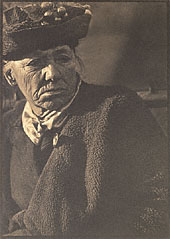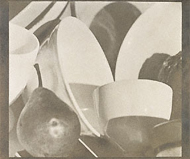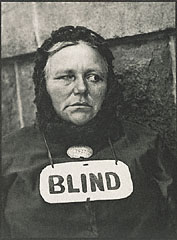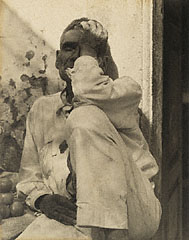|
"Three important roads opened for me....My work grew out of a response, first, to trying to understand the new developments in painting; second, a desire to express certain feelings I had about New York where I lived; third...I wanted to see if I could photograph people without their being aware of the camera." —Paul Strand
American photographer Paul Strand (1890–1976) pursued his three roads throughout his lengthy career while simultaneously espousing his political, humanistic beliefs through his art. In an attempt to reach a wide audience, he published five books that combine text with images to convey his message. This exhibition surveys Strand's work from 1913 through 1954 with works from the Getty Museum's permanent collection.
|
 |
|
Early in his career Strand saw the work of painters Paul Cézanne, Georges Braque, and Pablo Picasso at the Armory Show, held in New York in 1913. Intrigued with their abstract compositions, Strand began applying similar principles to his photographs and using a straightforward, realistic approach to his subjects.
In this cubist-inspired still life, Strand uses light and shadow to define the arrangement of shapes and forms. He removes the dishes from their context, stacking them in an apparently random arrangement with the silhouette of the pear. He creates a relationship that is not dictated by content or subject matter, but by simple form.
|
 |
 |

 |
 |
Driftwood, Maine 1928
© Aperture Foundation
|
 |
From 1925 to 1928 Strand made numerous trips to Georgetown Island, Maine, to make photographs and visit his friend the sculptor Gaston Lachaise. Drawn to natural elements, Strand approached organic forms much as he had his abstract still lifes or machine age subjects. But here he rejected the urban landscape and material objects—products of industrialization—and turned to a more fundamental subject: nature.
During this time Strand was influenced by Clive Bell, the British art critic and philosopher of art. Bell advocated the idea of "significant form," which he described as when "lines and color combined in a particular way, certain forms and relations of forms stir our aesthetic emotions."
|
 |
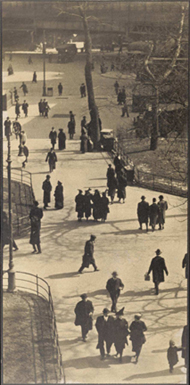
 |
 |
City Hall Park, New York, 1915
|
 |
 |
Strand was interested in portraying realistic scenes of New York that expressed the pulse and dynamism of the modern city. Here he stood above the scene, looking down on the silhouetted figures to capture a view of kinetic energy, where the people are not only caught in motion but also scattered across the composition.
With its nontraditional perspective and elongated format (Strand cropped the original negative), the composition evokes Japanese scrolls. He was very deliberate in creating this picture, removing a figure from the lower half of the negative, leaving a lingering shadow as evidence.
In 1920 Strand made a short film with Charles Sheeler about New York City titled Manhatta.
Video: Watch Manhatta (links to The Metropolitan Museum's Web site)
|
 |
 |
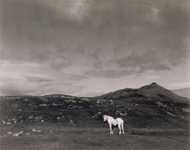
 |
 |
White Horse, South Uist, Scotland, 1954
© Aperture Foundation
|
 |
 |
|
Strand traveled extensively, spending long periods of time in Mexico, France, Italy, and Scotland. In each location his photographs define a sense of place. Strand left the United States permanently in 1950 to settle in France where he worked until his death in 1976.
In 1954 Strand spent three months in South Uist, an island in the Outer Hebrides of Scotland. In 1962 he published Tìr a'Mhurain (Land of Bent Grass), which reproduces his images of the community alongside text by the British cultural historian Basil Davidson. These views evoke the tranquility of existence on this remote island, seemingly free from the impact of the modern world.
|
 |
|
In 1916 Strand began using a camera fitted with a false lens that allowed him to photograph people without them being aware of it. With his new device, Strand created many strong and commanding portraits of the average citizens on the streets of New York.
His portraits do not tell who the people are, but his detailed recording of their faces separates the individual from the masses. Strand focused on this woman and her plight, forcing the viewer to confront her, whereas on the street she might be ignored.
|
 |
|
Strand lived in Mexico from 1932 to 1934. Deeply moved by the spirit of the Mexican people and their struggle for survival, he went to small towns and created a series of portraits of the local inhabitants. With a prism lens fitted to his camera, Strand was, once again, able to photograph people on the streets without their awareness. Strand usually chose a neutral background, often a wall, to enhance the expressions and faces of these people, all of which seem marked by the hardships of life.
In 1940 a selection of these portraits was published in a limited edition portfolio, Photographs of Mexico, depicting Mexican culture through its landscapes, vernacular architecture, and inhabitants.
This exhibition is located at the Getty Center, Museum, West Pavilion.
This exhibition is sponsored by 
|
 |
